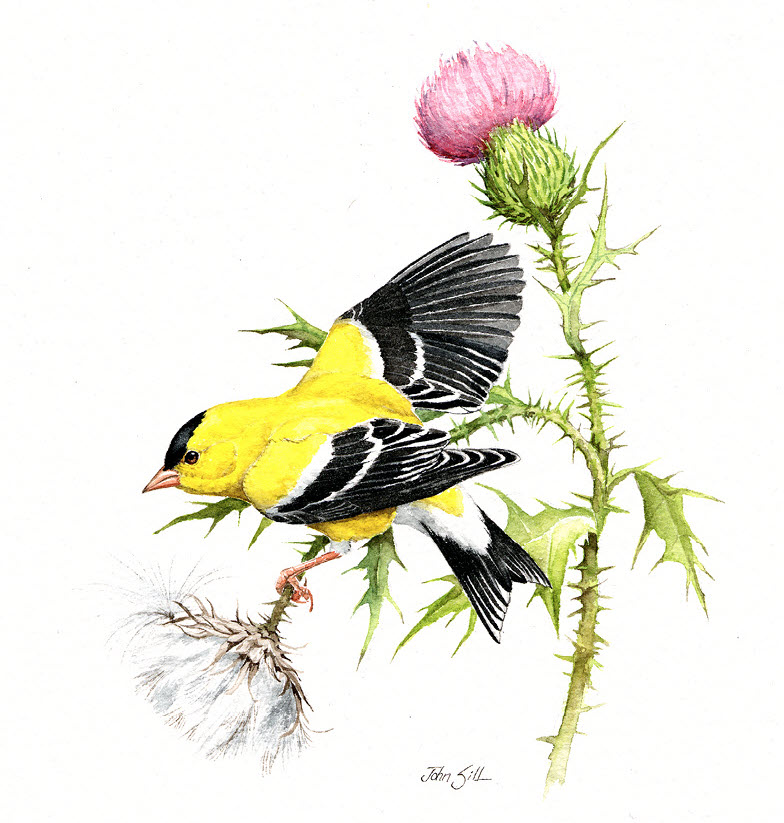American Goldfinch by John Sill

American Goldfinch by John Sill © Massachusetts Audubon Society. Courtesy of the Museum of American Bird Art.
John Sill is a freelance wildlife artist living in the mountains of North Carolina. He was the illustrator for the Bird Identification Calendar for Mass Audubon for many years. His work has appeared in Birds In Art at the Leigh-Yawkey Woodson Art Museum, Wausau, Wisconsin, and in Art of the Animal Kingdom at the Bennington Center for the Arts in Vermont. He continues to illustrate the "About" and "About Habitats" series of natural history books for children written by his wife Cathryn.
American Goldfinch
The American Goldfinch (Spinus tristis) is a common species that is sexually dimorphic in plumage. It is also seasonally dimorphic. In breeding plumage, the male is a striking, bright yellow and has a black forehead and tail, black wings with a single white wing bar, and a white rump. The bill and legs are pink. Duller than the male, the female in breeding plumage is yellowish below and brownish yellow above; she has a blackish tail and wings with two prominent yellowish wing bars, and lacks the white rump. Both males and females have white undertail coverts and white underwing coverts that are obvious in flight. In nonbreeding plumage, females are a drab light gray with two buffy or yellowish wing bars. Nonbreeding males resemble the female but have more yellow on the throat. Separating the American Goldfinch from the western goldfinch species can be tricky, but in Lawrence's Goldfinch, the male has a blackish face and the female a dusky one. The Lesser Goldfinch has obvious white patches in the wings in flight and lacks white undertail coverts.
The breeding range of the American Goldfinch extends across southern Canada from British Columbia to Newfoundland, and across the United States from Oregon and Washington to the East Coast, dipping south into Nevada in the west, the Carolinas in the east, and the northern parts of the Gulf States. The Canadian populations are migratory as are those from the Rocky Mountains in the United States. The other populations are year-round residents. Migrant American Goldfinches winter in the southern United States to parts of northern Mexico. Winter flocks tend to be nomadic, constantly searching for their patchily distributed food. American Goldfinches prefer early successional woodlands and forest habitats, weedy fields, orchards, and suburban environments such as gardens.
The American Goldfinch is one of the latest breeders of all North American bird species. This late breeding is probably related to the late flowering season for thistles, which is one of the species' most important food plants. They also line their nests with thistle down. In Massachusetts, where they are common and widespread breeders and residents, goldfinches nest between mid-July and September. Migrating goldfinches pass through Massachusetts during early spring and mid-fall.
The male goldfinch's song is a warbling series of notes that serves to attract females and to advertise territories. Song learning lasts into adulthood and breeding pairs develop nearly identical flight calls, which probably serves to identify their mates. A common vocalization is a short and high-pitched contact call. Goldfinches also have a variety of alarm, distress, and feeding calls. The usual flight pattern for goldfinches is the typical undulating flight of other finches accompanied by flight calls. The male also performs a display flight using slow, exaggerated wing beats. Aggressive displays include the male crouching with head forward, wings raised, bill open, and uttering harsh calls.
American Goldfinches are usually monogamous, but females may mate with a different male to produce a second brood. Pair formation may occur either in winter flocks or on the nesting grounds. Courtship feeding by males is common. Both members of a pair select the nesting area, but the final nest site—usually in a deciduous shrub or small tree—is chosen by the female. The nest is also built by the female. It is a compact bowl of plant fibers and rootlets that is attached to several twigs with spider silk. The female develops a brood patch and she alone incubates the usual clutch of five bluish-white eggs for the 12–14 days until hatching. The helpless chicks hatch nearly naked with their eyes closed. For the first few days after the chicks hatch, the male brings food for the female and she feeds the chicks. Thereafter, both parents collect food for the young. If disturbed at the nest, the female gives a distraction display, fluttering to the ground and flopping about. Fledging varies but averages about two weeks, with the parents continuing to feed the young birds for an additional three weeks. Because of the late date for nesting, cowbird nest parasitism is minimal. When it does occur, the cowbird chicks fail to develop—apparently because the goldfinch's seed diet lacks sufficient protein for cowbirds—and they die.
American Goldfinches forage primarily on the seeds of small trees and plants, especially those of the family Compositae. Thistle seeds are among their favorites and they also take the seeds of grasses. Herbivorous, they only occasionally take insects. They often frequent bird feeders, especially thistle seed feeders. They forage from the ground or by hanging from seed heads, often upside down. They do not cache seeds, nor do they defend the resources they exploit. Goldfinches are gregarious and, in winter, often are found in large mixed-species flocks that include chickadees, titmice, and several sparrow species.
Nest predators of American Goldfinches include snakes, weasels, and squirrels. Predators of adults and fledglings include falcons, shrikes, and domestic cats. Breeding Bird Census data suggest decreasing populations in the East but stable populations in the West. However, Christmas Count data suggest a stable population. It appears likely that this beautiful, abundant, and widespread species will grace our gardens into the indefinite future.
William E. Davis, Jr.